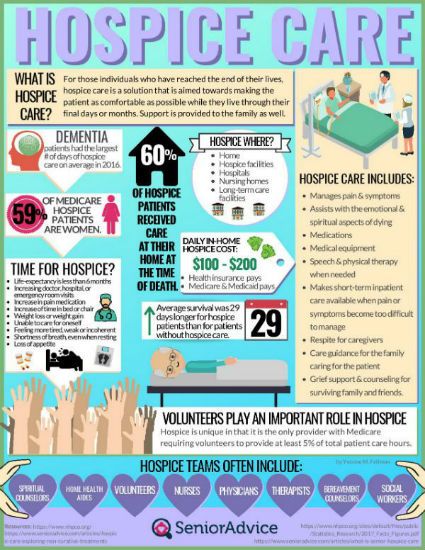About Hospice Care

For those individuals who have reached the end of their lives, hospice is a solution that is aimed towards making them as comfortable as possible while they live through their final days. Hospice care can be provided in-home or in a hospice facility, and providers will typically take care of all an individual's needs while they are in hospice care. This includes palliative care to help ease any pain or discomfort the individual may experience. Hospice helps both patients and their loved ones come to terms with terminal illnesses, and can be a great source of relief in a difficult time. Care may be available in private pay facilities, through charitable organizations, or through government-funded programs.
Top Cities for Hospice in the US
- Houston, TX
- Tucson, AZ
- San Antonio, TX
- Chicago, IL
- Phoenix, AZ
- Seattle, WA
- Portland, OR
- Dallas, TX
- Indianapolis, IN
- Denver, CO
- Cincinnati, OH
- Scottsdale, AZ
- Los Angeles, CA
- Baltimore, MD
- Vancouver, WA
- Mesa, AZ
- Austin, TX
- Columbus, OH
- Atlanta, GA
- Bellevue, WA
- San Diego, CA
- Jacksonville, FL
- Minneapolis, MN
- San Jose, CA
- Albuquerque, NM
- Sacramento, CA
- Chandler, AZ
- St Louis, MO
- Colorado Springs, CO
- Fresno, CA
What is Hospice Care?
Hospice care, also called end-of-life care, is defined as the care one receives when they have less than six months to live. This type of care includes spiritual, psychological and medical support from volunteers and medical professionals. Hospice care can last for a few days or a few months. The main goal of this type of care is to provide comfort and reduce pain and other ailments so the dying loved one can have as much dignity and peace as possible during the last days, weeks or months of their life. Most Hospice programs provide family support as well. Hospice can occur in several different settings:
- At a hospice center
- At home
- In a hospital
- In a nursing home, a skilled nursing facility, or another residential facility
Not to be confused with palliative care which can be given at any time during the course of an illness and in conjunction with aggressive treatments, hospice requires four areas of service such as: routine home care, continuous nursing care at home, respite care and facility in-patient care. These include physician and social worker participation, counseling, medications, health aides, medical supplies and equipment, labs or other diagnostic tests, therapy and other assistance.
In 2014, nearly 60% of hospice patients received care at their home at the time of death, the average length of hospice care being just over 17 days. According to the National Hospice and Palliative Care Organization, hospice programs in the US have grown steadily since 1974 with over 5,800 programs in 2013. In 2014, an estimated 1.6-1.7 million patients received hospice services.
Federal, state, and professional organizations evaluate hospice programs. Ongoing surveys ensure that they meet the standards developed by the National Hospice and Palliative Care Organization. The state licenses and Medicare certifies all hospice services.
When Is It Time to Choose Hospice Care?
Deciding whether to seek hospice services can be a difficult time for any family. There is mounting data that suggests that usually hospice is sought too late. Here are some of the situations that may indicate it is time to explore hospice options:
- One or more doctors have indicated that life-expectancy is six months or less
- More frequent doctor, hospital, or emergency room visits
- Increase in pain medication
- More time spent in a bed or chair
- Weight loss or weight gain
- Needing more assistance with activities of daily living such as dressing or walking
- Feeling tired, weak or incoherent
- Shortness of breath, even when resting
- Loss of appetite
Volunteers Are a Special Part of Hospice
Unlike any other short-term or long-term senior care option, a hospice program requires the use of trained volunteers. The Medicare law enacted in the US in 1982 requires that volunteer hours equal at least five percent of the hospice provider’s total patient care hours. The idea was that, along with maximizing healthcare resources, volunteers would keep hospice providers community oriented and patient-and-family focused. The idea stuck and today hospice volunteers devote more than 20 million hours annually to patients and their families nationwide.
How Much Does Hospice Care Cost and How Do I Pay?
Hospice care is usually less expensive than conventional medical care during the last six months of life. Hospice care is covered by most private health insurance carriers, nationwide by Medicare and through Medicaid at the state level.
Medicare and Medicaid
Hospice services are covered by Medicare and Medicaid in most states. These programs pay for most services needed to manage pain and to promote comfort in the last weeks or months before death. For more information, a helpful video is available from the Centers for Medicare and Medicaid Services (CMS). For a booklet of these benefits visit the Medicare website.
Hospice Organizations and Charities
Although most hospice care is paid for by Medicare, there are many hospices that are charitable, nonprofit organizations which receive charitable donations from other charitable organizations or companies, or from private individuals in the community. These donations are used to provide services for those hospice patients who have no other means of paying.
According to findings in a 2014 Washington Post article, the number of hospice firms has risen rapidly, and over the past decade the growth has come almost entirely from new for-profit operations. Between 2000 and 2012, the number of for-profit hospices tripled to 2,196, according to federal data, compared with about 1,500 nonprofit hospices, including those run by local governments. The quality of hospice care can vary widely. The article goes on to say, “The findings on for-profit hospices come amid repeated complaints within the industry that pressure to cut costs, combined with sparse government oversight, has led some companies to focus on the bottom line to the detriment of patients.”
Whether it is a nonprofit or for-profit organization, it is important to choose a hospice provider carefully. A directory of hospice organizations can be found on the Hospice Foundation of America website or via Hospice Compare on the Medicare website.
Aid and Attendance Benefit for Veterans
According to the VA website, the Aid and Attendance (A&A) benefit is a special benefit for war era veterans and their surviving spouses. It is a tax-free benefit designed to provide financial assistance to help cover the cost of long-term care in the home, in an assisted living facility or in a nursing home. This includes hospice care. This benefit is for those who require the regular attendance of another person or caregiver in at least two of the daily activities of living. To learn more about the eligibility requirements and to apply for these veteran benefits visit VeteransAid.org online.
Long-term Care Insurance
Long-term care insurance is a policy that is purchased through a private insurance company. Many insurance companies model their Hospice benefit coverage on the Medicare Hospice Benefit program, but coverage may vary. Similar to health insurance policies, the price varies greatly depending on age, general health and amount of coverage. Coverage could be denied for people with pre-existing conditions such as Alzheimer's disease or Parkinson's disease. Not all insurance will deny based on these conditions so it is important to explore different insurance companies.
Private Funding
In situations when hospice costs aren’t covered through charities, insurance, Medicare or Medicaid, paying via private funds is an option. Sources of private funds for hospice include retirement accounts and 401Ks, savings accounts, annuities, trusts and stock market investments. Social Security can also be a payment solution for those who are seeking hospice care.
Additional Hospice Resources
- What is Senior Hospice Care?
- Talking to Grandchildren About End-Of-Life Care
- Hospice Care: Exploring Non-Curative Treatments for Terminal Patients
- Hospice Care vs. Palliative Care: What is the Difference?
Top Articles in Hospice
View All
Talking to Grandchildren About End-Of-Life Care
When a senior starts end-of-life care, it can be a difficult time for friends, family members and caregivers alike. This time can be emotional and draining and it can take a toll on many of the individuals involved. However, many times during all of the turmoil surrounding end-of-life care, many fam...More
Read More
Non-Curative Hospice Treatments
The disease came with little warning - fast-spreading cancer, devastating cells and tissue within a matter of mere weeks. There was no way to guard against it; there was no way to prepare; and you fear there's nothing left to do now but watch the symptoms grow, leaving your loved one in constant...More
Read More
What is Senior Hospice Care?
You never planned for this: the pervasive presence of a chronic illness, a loved one's sudden inability to perform even the simplest tasks. The scenario never seemed possible, but now it proves all too real, and you're struggling to provide the necessary support. Fortunately, you don't have to bear ...More
Read More

 Your Information is Processing
Your Information is Processing